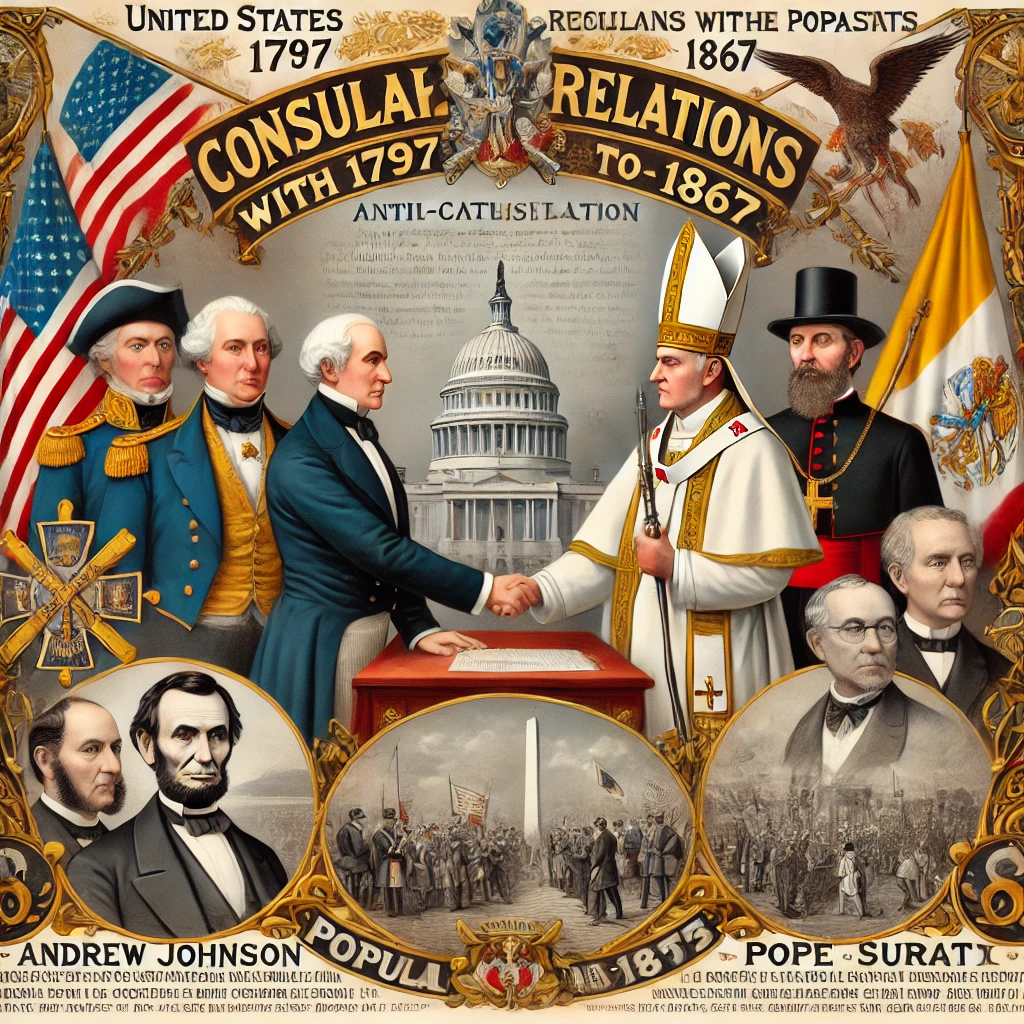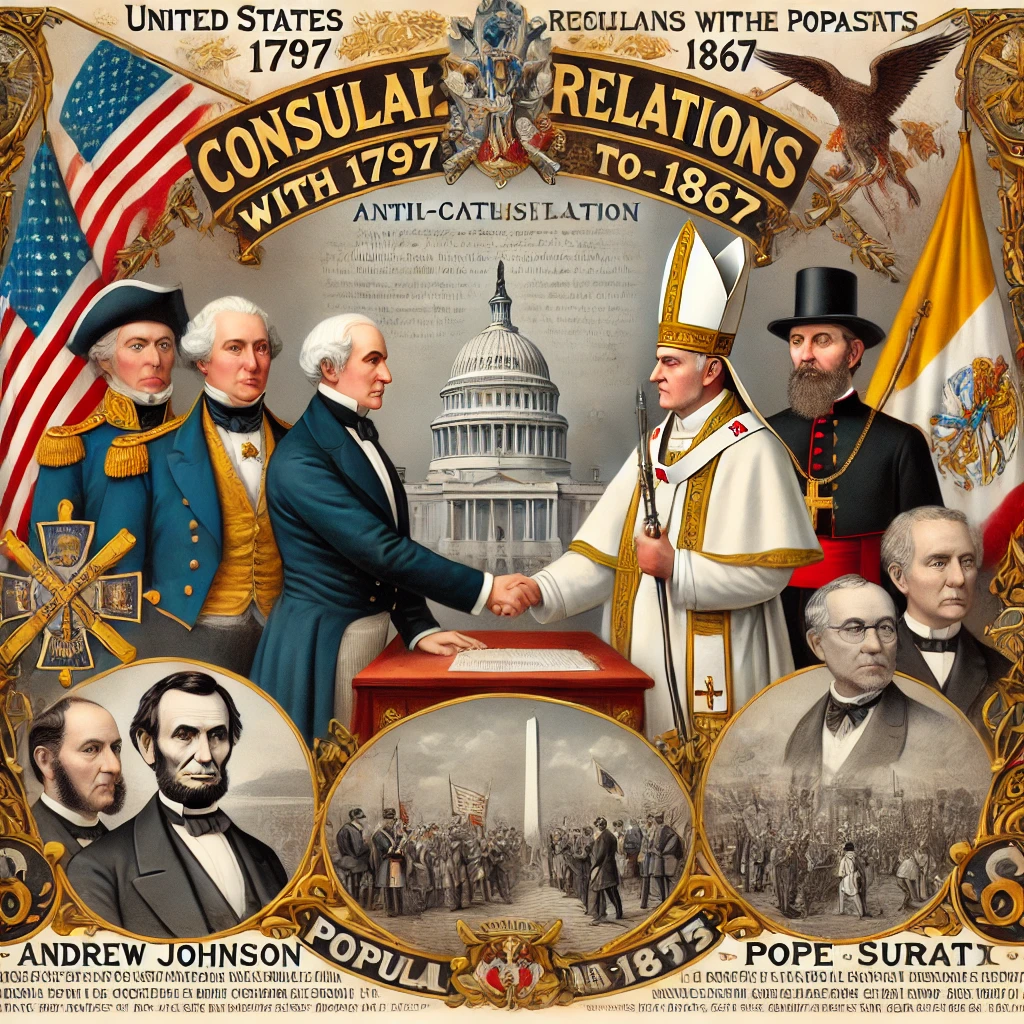117 years of Excommunication with Vatican
SOURCE https://michaelruark.wordpress.com/2022/04/16/us-did-not-have-relations-with-holy-see-for-117-years/
The principal United States official is Chargé d’Affaires Patrick Connell, who officially started at his position on January 20, 2021. The U.S. Embassy to the Holy See is located in Rome, in the Villa Domiziana.
The Holy See is represented by its apostolic nuncio, Archbishop Christophe Pierre, who assumed office on April 12, 2016. The Nunciature to the United States is located in Washington, D.C., at 3339 Massachusetts Avenue, N.W.
History
1797–1867
The United States maintained consular relations with the Papal States from 1797 under President George Washington and Pope Pius VI to 1867 and President Andrew Johnson and Pope Pius IX. Diplomatic relations existed with the Pope, in his capacity as head of state of the Papal States, from 1848 under President James K. Polk to 1867 under President Andrew Johnson, though not at the ambassadorial level.
These relations lapsed when on February 28, 1867, Congress passed legislation that prohibited any future funding of United States diplomatic missions to the Holy See. This decision was based on mounting anti-Catholic sentiment in the United States, fueled by the conviction and hanging of Mary Surratt, and three other Catholics, for taking part in the conspiracy to assassinate President Abraham Lincoln.
Her son, John Surratt, also Catholic, was accused of plotting with John Wilkes Booth in the Assassination of Abraham Lincoln. He served briefly as a Pontifical Zouave but was recognized and arrested. He escaped to Egypt but was eventually arrested and extradited. There was also an allegation that the Pope had forbidden the celebration of Protestant religious services, previously held weekly in the home of the American Minister in Rome, within the walls of the city.

1867–1984
From 1867 to 1984, the United States did not have diplomatic relations with the Holy See, having been prohibited by Congress in the wake of anti catholic implication in the Lincoln assassination. The critics finally won out in 1867 when Congress withdrew all funding for the legation in Rome. The apparent reason was a rumor relating to the religious freedom of Protestants in the Papal States.
From the beginning of the legation in Rome, Papal authorities had allowed the celebration of Protestant religious services in the home of the American Minister. When the services grew, they were moved to a rented apartment under the seal of the American Legation to accommodate the participants. The news floating around Washington and being reported in the New York Times was that the Pope had forced the protestant group outside the walls of Rome. This, according to Rufus King, the American Minister himself, was untrue in its entirety.
In his June 1908 apostolic constitution, Sapienti Consilio, Pope Pius X decreed that, as of November 3 that year, the Catholic Church in the United States would no longer be supervised by the Vatican’s missionary agency, the Congregation for the Propagation of the Faith (Propaganda Fide). The U.S. Church would now be a mission-sending Church, not “mission territory.”
Several presidents designated personal envoys to visit the Holy See periodically for discussions of international humanitarian and political issues. Postmaster General James Farley was the first of these representatives. Farley was the first high ranking government official to normalize relations with the Holy See in 1933 when the Postmaster General set sail for Europe, along with Soviet Commissar of Foreign Affairs Maxim Litvinov on the Italian Liner SS Conte di Savoia. In Italy, Farley had an audience with Pope Pius XI, and dinner with Cardinal Pacelli, who was to succeed to the papacy in 1939. Myron Charles Taylor served Presidents Franklin D. Roosevelt and Harry S. Truman from 1939 to 1950.
Presidents Nixon, Ford, Carter, and Reagan also appointed personal envoys to the Pope. Also, all of these presidents, in addition to Truman, Eisenhower, Kennedy, Johnson, and all later presidents, along with the first ladies, in diplomatic dress code black and mantillas, have visited the Vatican, during the course of their administrations.
On October 20, 1951, President Truman nominated former General Mark W. Clark to be the United States emissary to the Holy See. Clark later withdrew his nomination on January 13, 1952, following protests from Senator Tom Connally (D-TX) and Protestant groups. The official prohibition lasted until September 22, 1983, when it was repealed by the “Lugar Act”.
The Vatican has historically been accused of being un-American, at least until the presidency of John F. Kennedy (see Americanism (heresy), nativism and anti-Catholicism in the United States). The bulk of the accusation is found in Paul Blanshard’s book American Freedom and Catholic Power, which attacked the Holy See on grounds that it was a dangerous, powerful, foreign and undemocratic institution.
1984–present
The United States and the Holy See announced the establishment of diplomatic relations on January 10, 1984. In sharp contrast to the long record of strong domestic opposition, this time there was very little opposition from Congress, the courts, and Protestant groups.
On March 7, 1984, the Senate confirmed William A. Wilson as the first U.S. ambassador to the Holy See. Ambassador Wilson had been President Reagan’s personal envoy to the Pope since 1981.
The Holy See named Archbishop Pio Laghi as the first Apostolic Nuncio (equivalent to ambassador) of the Holy See to the U.S. Archbishop Laghi had been Pope John Paul II’s apostolic delegate to the Catholic Church in the United States since 1980.
Relations between President Ronald Reagan and Pope John Paul II were close especially because of their shared anti-communism and keen interest in forcing the Soviets out of Poland. Also, the two men forged a common bond over having survived assassination attempts just six weeks apart in the spring of 1981. [Was that pair of related events organic, or more theatrics?]
July 10, 2009 – President Barack Obama and Pope Benedict XVI met in Rome.
March 27, 2014 – Obama and Pope Francis met in Rome.
September, 2015 – Pope Francis visited Cuba, Washington, D.C., New York City.
June 2015 – US and the Holy See agreed to automatic exchange of tax information to stymie offshore tax-evasion.
May 2017, President Donald Trump met with Pope Francis in the Vatican.
October 2021 – President Joe Biden met with Pope Francis in the Vatican.
